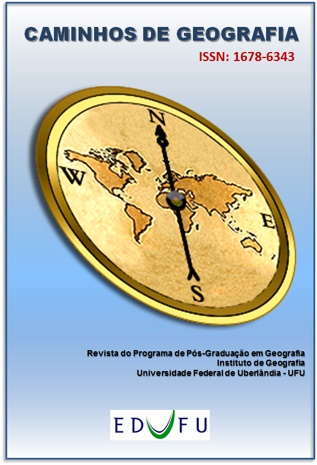ANALYSIS OF THE DEGREE OF GRASSLAND DEGRADATION USING REMOTE SENSING
DOI:
https://doi.org/10.14393/RCG228054817Keywords:
Urban growth., Spatial planning., Urban legal instruments., Real estate speculation.Abstract
The objective of this study is to adapt the calculations of the Pasture Degradation Index (GDI) to the Brazilian savannah using medium spatial resolution satellite image for the dry season. Vegetation cover is the main evaluation parameter used to calculate the GDI. The extreme ranges of the grazing class were determined by the NDVI histogram of a single date. Pasture cover was distinguished into five classes called Vegetable Pasture Cover (GVC), derived from NDVI and compared with five other classes derived from field photographs, named Green Coverage Percentage (GCP). The similarity between GVC and GVP demonstrated that GVC can be used to classify pasture cover. As a product of GVC, GDI was obtained. The GDI showed that pasture degradation in Paraíso das Águas is very serious. Extremely severe and Severe degradation occupy 9.28% and 25.22% of the study area, moderate and light degradation of pasture occupy 8.29% and 4.50%, respectively, and the non-degradation area covers 1.43 % of pastures. The results suggest the possibility of applying the GDI, originally developed for natural fields and multitemporal remote sensing data, to evaluate the conditions of the tropical savanna planted fields by means of a unique image.
Downloads
Downloads
Published
How to Cite
Issue
Section
License
Autores que publicam nesta revista concordam com os seguintes termos: a) Autores mantém os direitos autorais e concedem à revista o direito de primeira publicação, com o trabalho licenciado sob a Creative Commons Atribuição-NãoComercial-SemDerivações 4.0 Internacional. b) Autores têm permissão e são estimulados a publicar e distribuir seu trabalho online (ex.: em repositórios institucionais ou na sua página pessoal), já que isso pode gerar alterações produtivas, bem como aumentar o impacto e a citação do trabalho publicado. c) Em virtude de aparecerem nesta revista de acesso público, os artigos são de uso gratuito, com atribuições próprias, em aplicações educacionais e não-comerciais.











